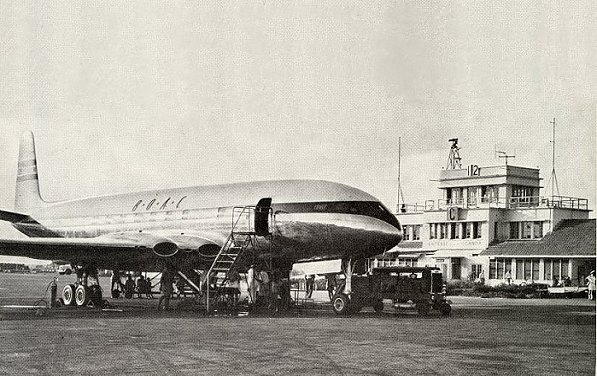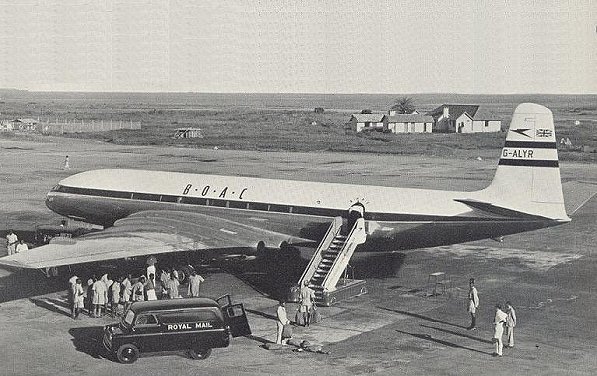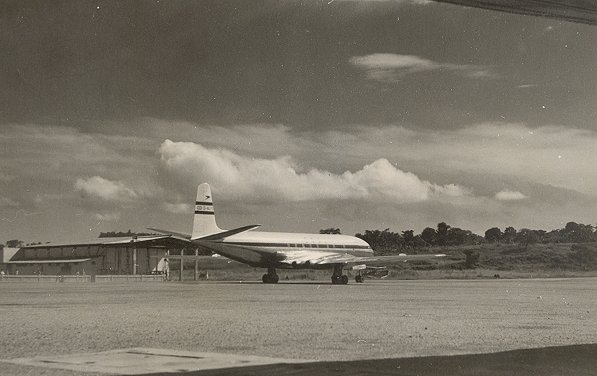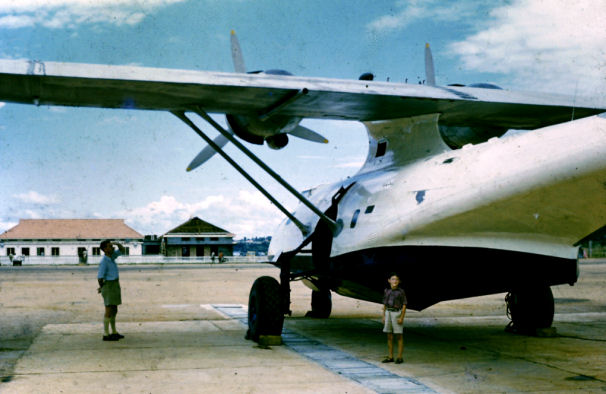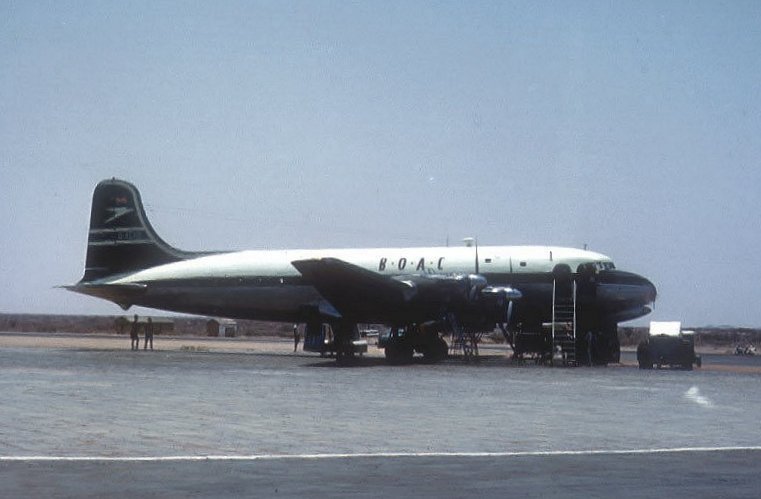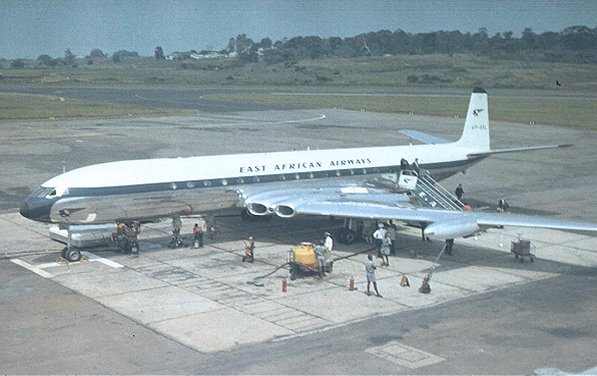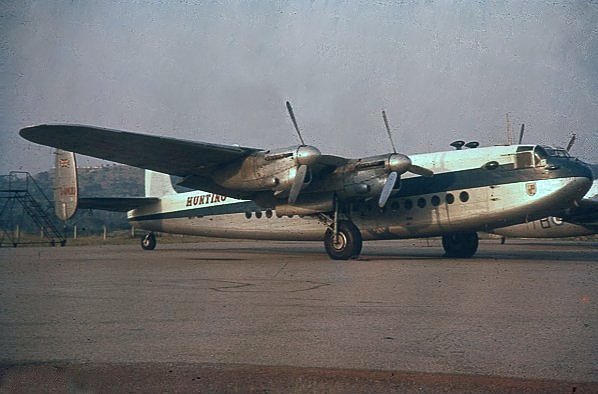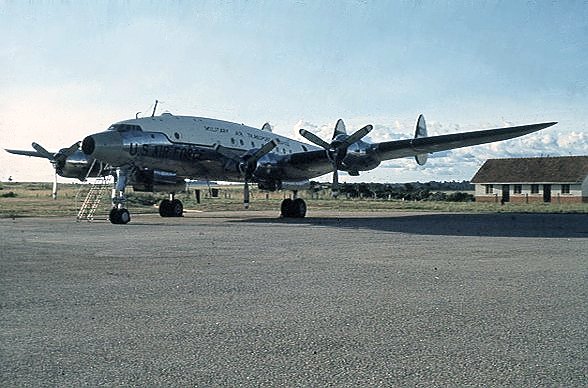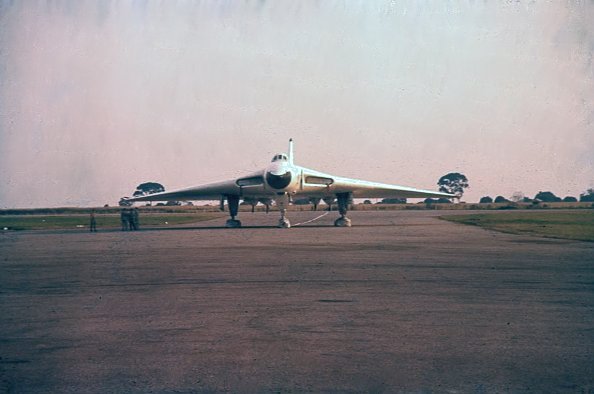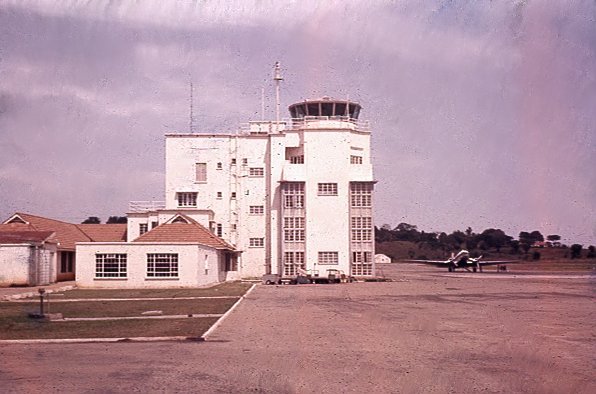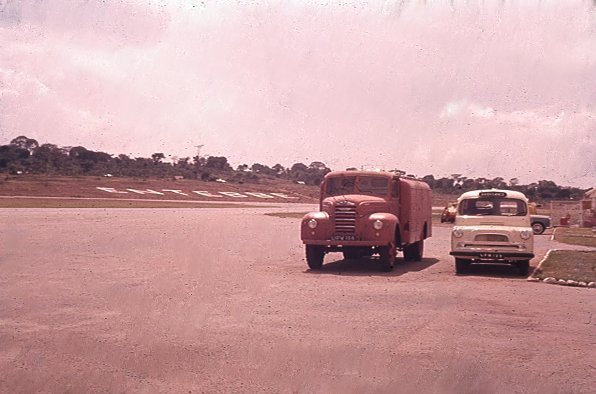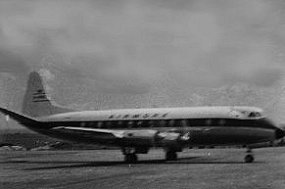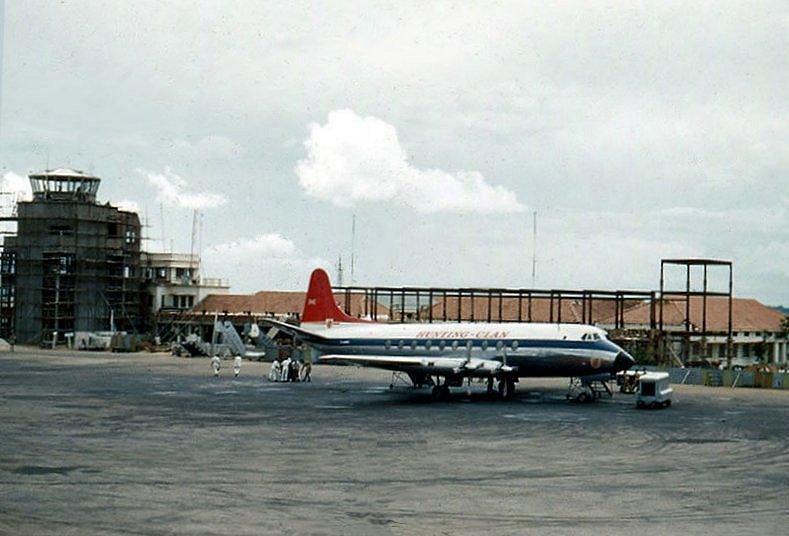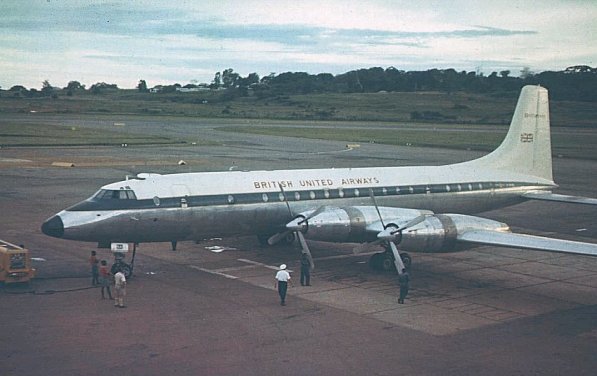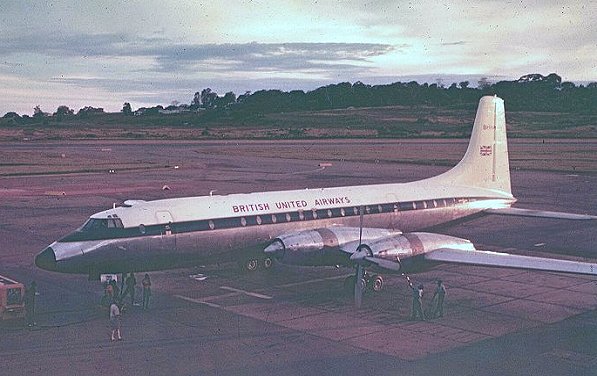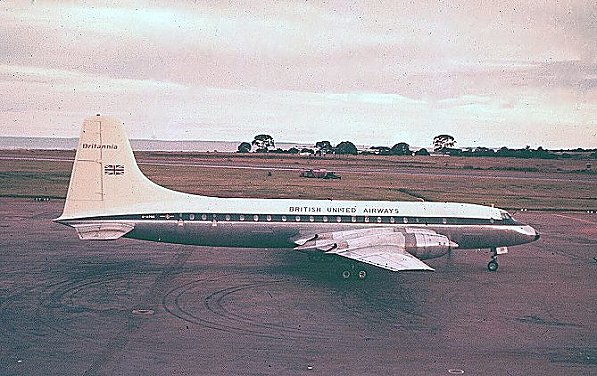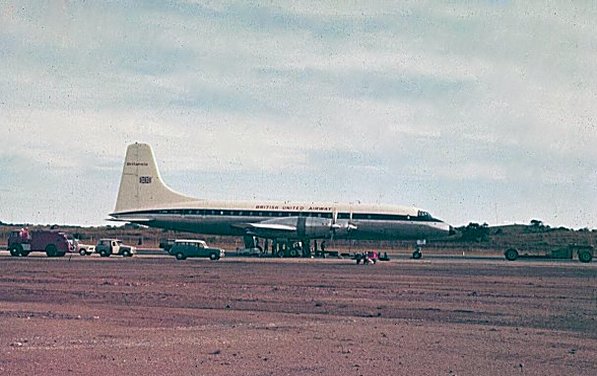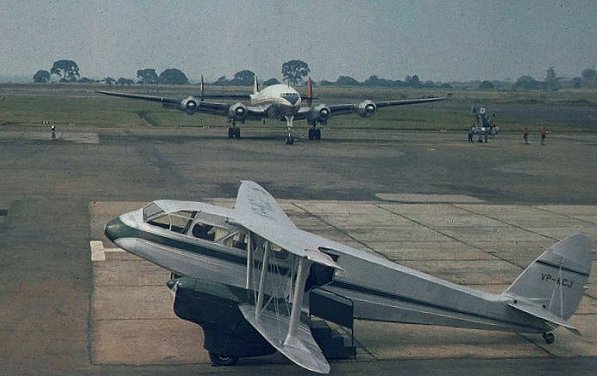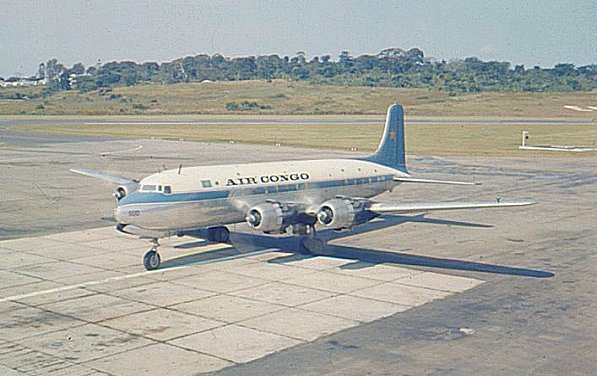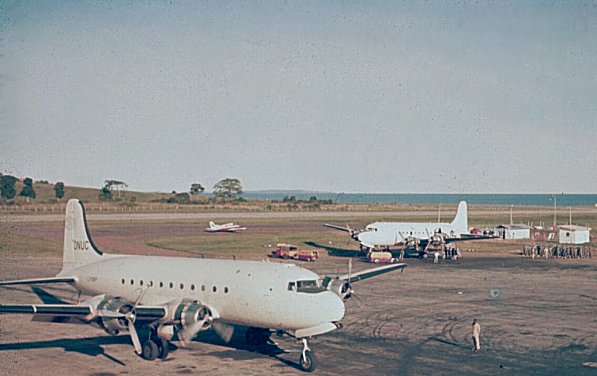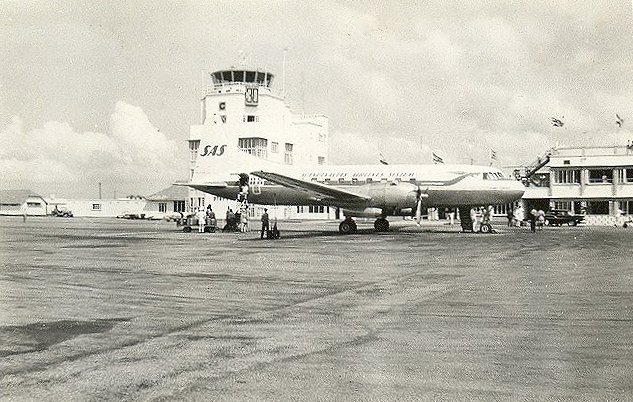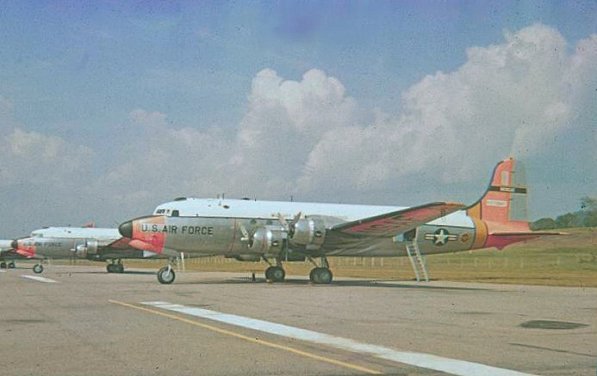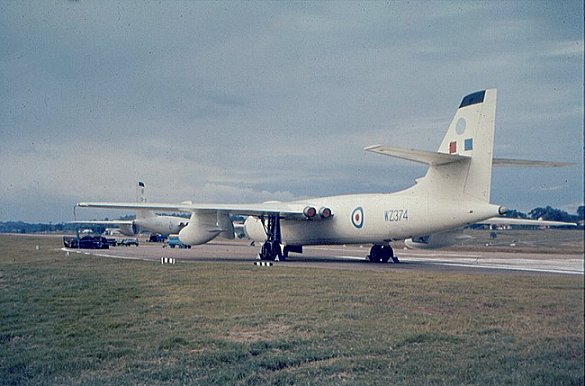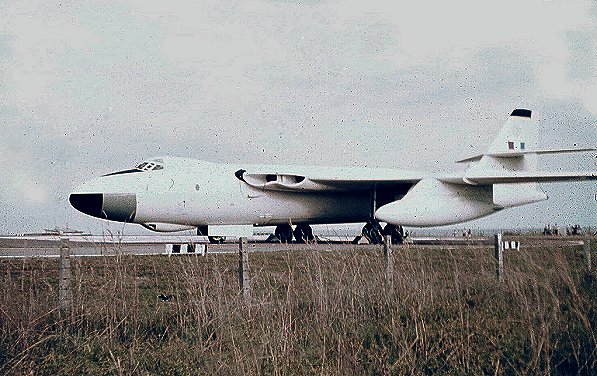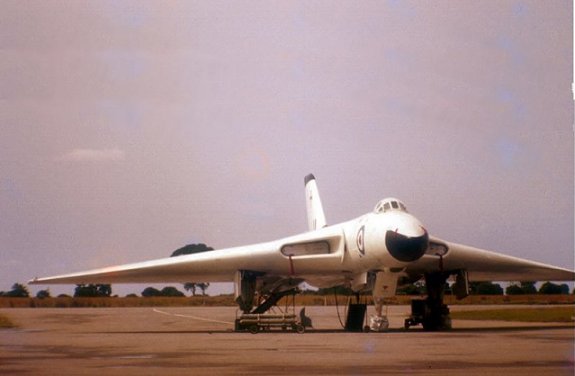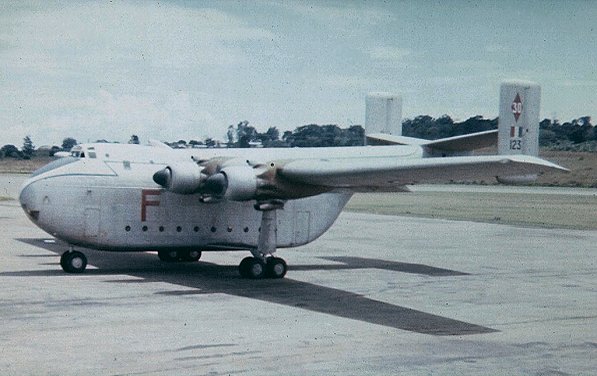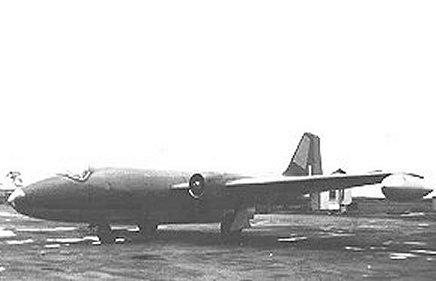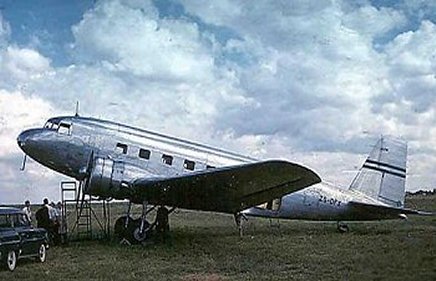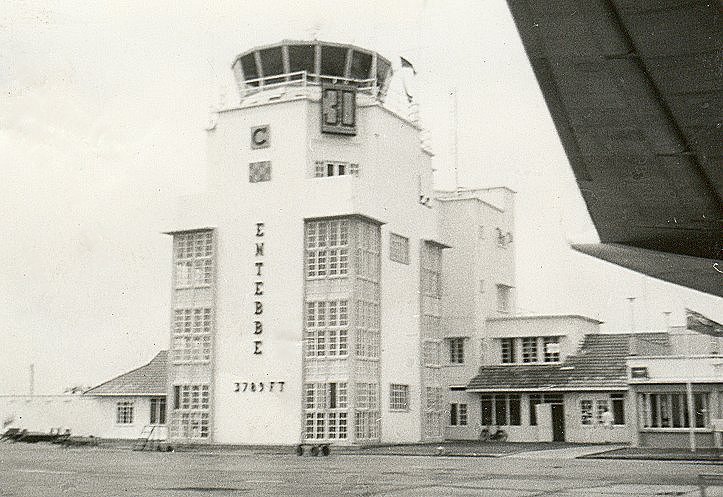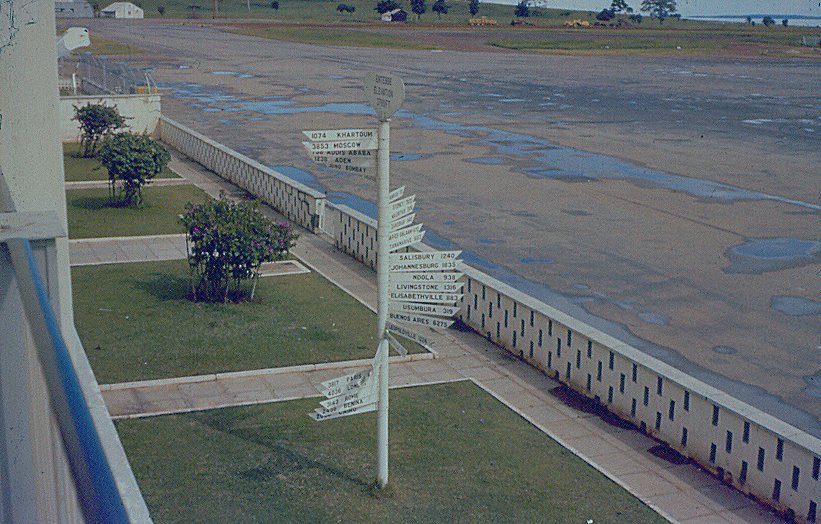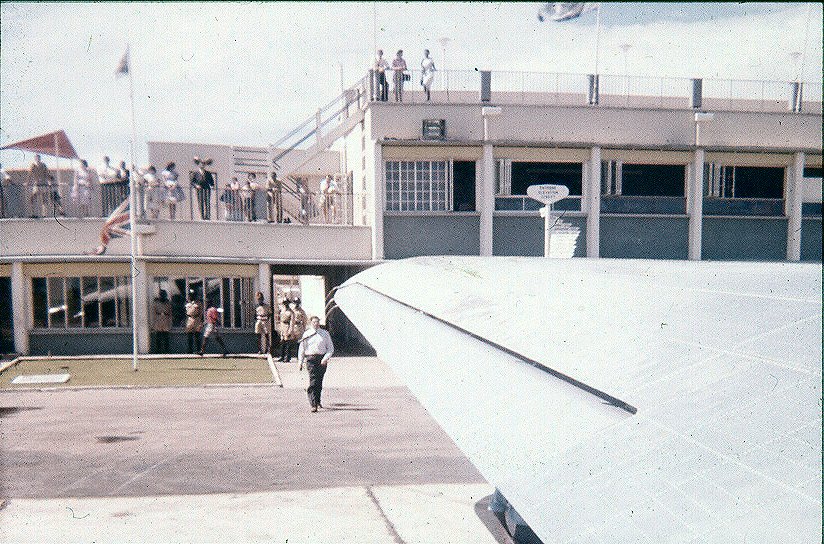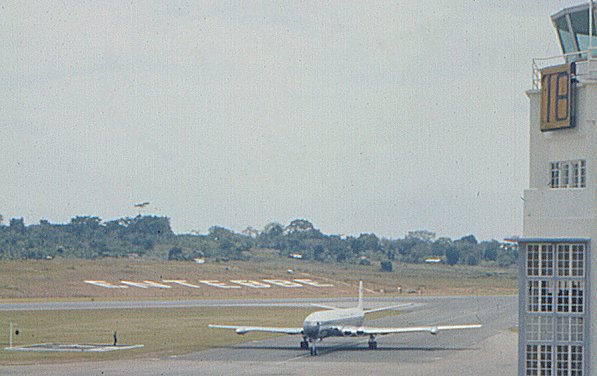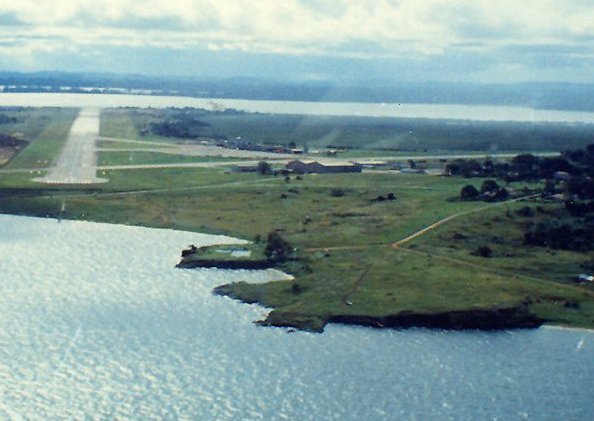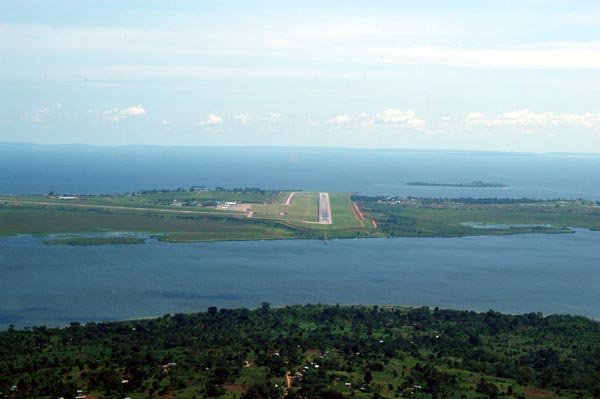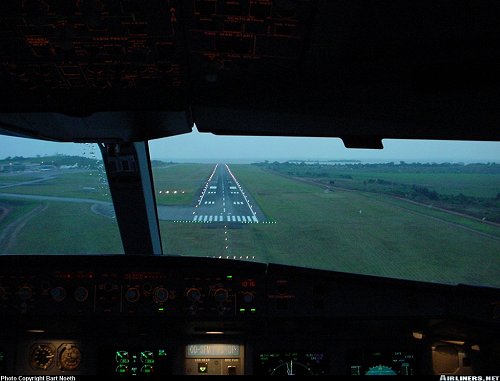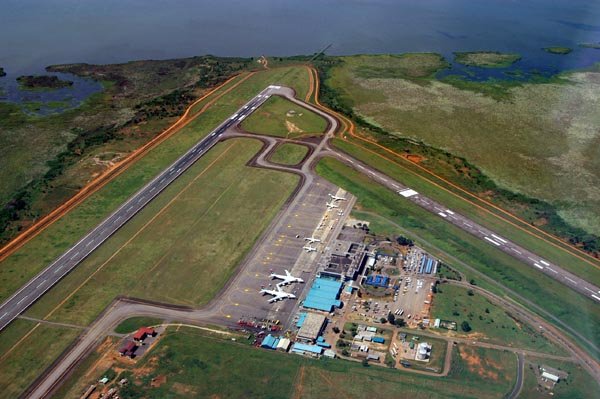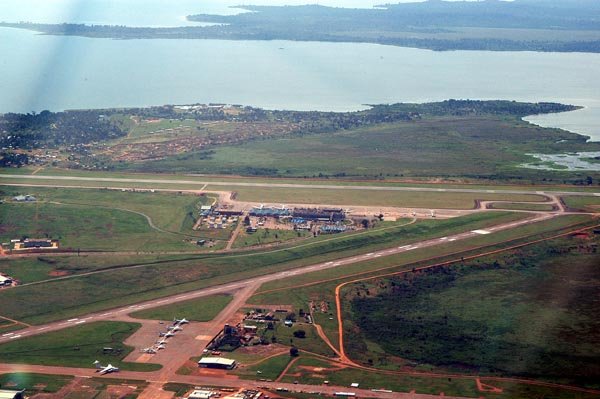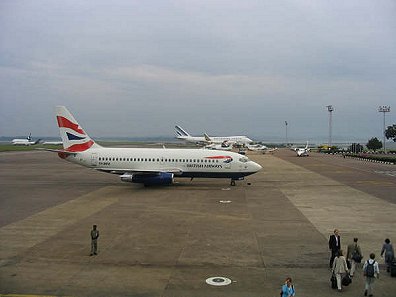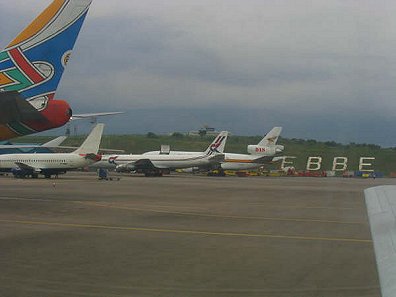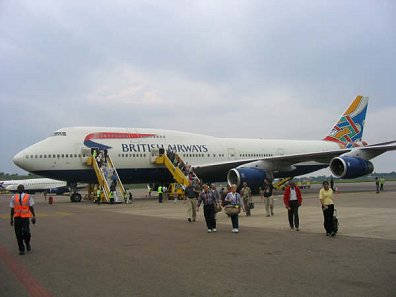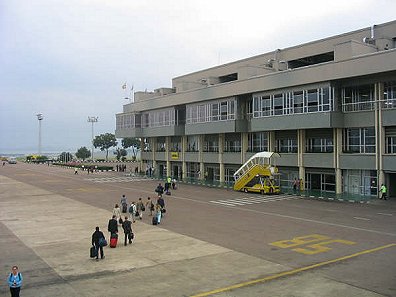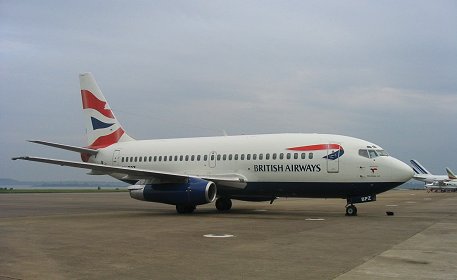|
Entebbe Airport 1 |
|||||
|
|
|||||
|
Entebbe Airport was built to accommodate the Comets which introduced the world's first jet service between London and Johannesburg. The original Control Tower and passenger buildings at Entebbe. The Comet Service was started in 1952 and operated jointly by BOAC and South African Airways. The Comet called at Rome, Cairo, Khartoum, Entebbe and Livingstone on its way to Johannesburg. PHOTO - Uganda Government |
|||||
|
|
|||||
|
Loading mail on to the Comet (above). Entebbe was chosen in preference to Nairobi as at 5,500 feet, Nairobi was too hot and too high for the Comet 1. It would not be until 1958 that the later Comet 4 was able to operate through Nairobi's then new Embakasi Airport. Comet services were to be short-lived. By 1954 they would be grounded due to metal fatigue which had caused disastrous structural failure in flight. PHOTO Uganda Government |
|||||
|
|
|||||
|
Comet G-ALYR taxies for Runway 30. Comet 1 Yoke Sugar (left) taxis out at Entebbe for Runway 30 . I acquired this photograph from the official collection of photographs in the Nairobi BOAC office in Sadler Street. With the demise of the early Comets, Sales Manager Tony Cruickshanks was happy to give it to me in 1960. PHOTO Daily Mirror (BOAC Nairobi, 1958). |
|||||
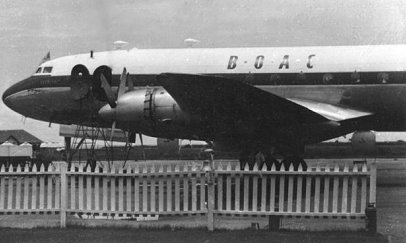 |
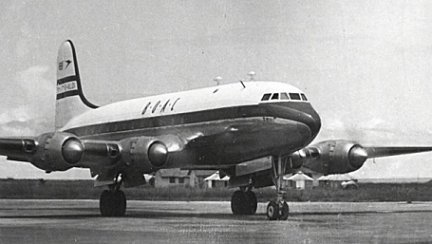 |
||||
| Prior to the introduction of the Comet 1, the Handley Page Hermes (above, left and right) was used between London and Nairobi with two Hermes flights per week transiting Entebbe. The Hermes had a relatively short career with BOAC and was soon replaced by the Canadair Argonaut which also replaced the ill-fated Comets. The two very rare photographs clearly show the Hermes G-ALDI at Entebbe where in 1955 it was possible simply to walk out on to the apron to greet disembarking passengers! How things have changed. Note the British Civil Aviation ensign flying above the flightdeck window while the Hermes was on the ramp. PHOTOs - Joe Barr | |||||
|
|
|||||
| Consolidated Catalina at Entebbe around 1952, probably during the filming of the movie "Mogambo" when such an aircraft was was certainly flown from Bukoba - where it hand landed on the Lake - to Entebbe (East African - An Airline Story, Peter J Davis) - PHOTO Richard Granville | |||||
|
|
|||||
| The more usual way of getting to Entebbe was by BOAC Argonaut. This was a Canadian built Douglas DC4 which was modified to take Rolls Royce Merlin engines and, unlike the DC4, boasted a pressurised cabin. The type was later to pass to East African Airways in a deal which seemed more in keeping with preserving BOAC's dominance of the route rather than allowing East African Airways to purchase modern US aircraft which would have competed with BOAC of which East African Airways was a subsidiary. Here a BOAC Argonaut in the final blue finned livery is seen at Entebbe. PHOTO Hugh Burt | |||||
|
|
|||||
|
In the 1960s, with their introduction by East African Airways, Comets were again daily visitors to Entebbe, although BOAC Comets were a rare sight - see below. PHOTO Malcolm McCrow |
|||||
|
|
|||||
| Hunting Clan Avro York freighter with what appears to be a Vickers Valetta of the UK Air Force in the background. Hunting Clan merged with Airwork around 1960 to form British United Airways. The York has the the same wings, fins and engines as the Avro Lancaster. PHOTO John Garside | |||||
|
|
|||||
|
US Air Force Military Air Transport Service C121B. PHOTO John Garside |
|||||
|
|
|||||
|
UK Air Force Avro Vulcan parked on the taxiway leading to Runway 12/30. PHOTO John Garside
|
|||||
|
Entebbe Tower looking towards the short runway. An East African Airways DC3 is the sole occupant of the apron. PHOTO John Garside |
|||||
|
|
|||||
|
How primitive the Ford Thames foam bowser and the Beford Utilicon ambulance look by today's standards. They are outside the Airport Fire Station where Ted Barker was one of the Firemasters. PHOTO John Garside |
|||||
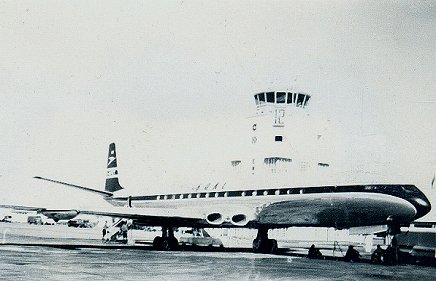 |
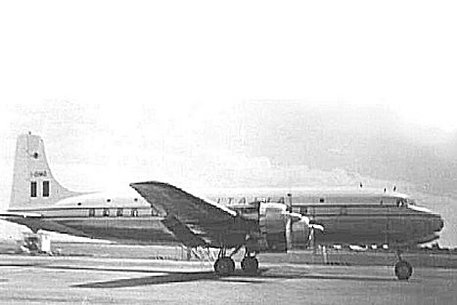 |
||||
| BOAC did not operate Comet 4s through Entebbe. G-APDT (left) diverted from Nairobi having come up from Salisbury. Despite Runway 12 being the duty runway, it landed downwind on a straight in approach to Runway 30. After its passengers had been sent off to the Lake Victoria Hotel, it hung around for some time before departing for Nairobi on three engines using Runway 12. An Alitalia DC6B (right) taxies for Runway 12. PHOTOs Malcolm McCrow | |||||
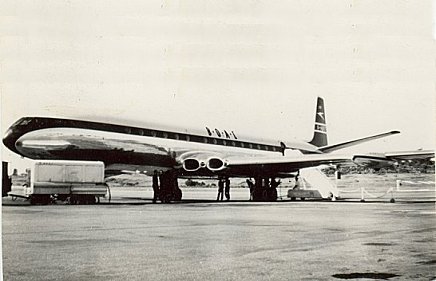 |
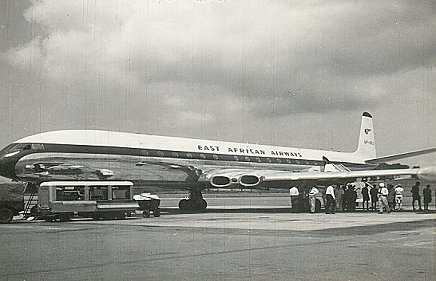 |
||||
| Comet G-APDT (left) on the ramp prior to its departure for Nairobi. It would be over a year later that East African Airways Comets began to appear at Entebbe. The first Comet to be delivered to East African Airways was VP-KPJ (right) | |||||
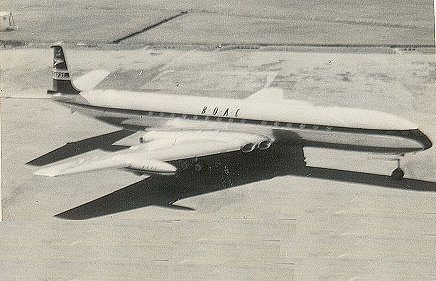 |
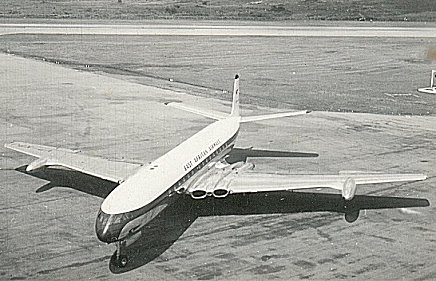 |
||||
| Views from the tower. Unscheduled BOAC Comet G-APDT (left) taxies for take-off on Runway 12 . East African Airways Comet 4 VP-KPJ (right) taxies to the ramp after arriving from Khartoum. PHOTOs Malcolm McCrow | |||||
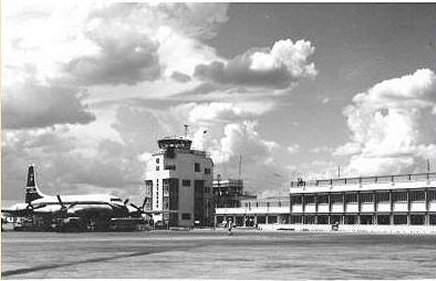 |
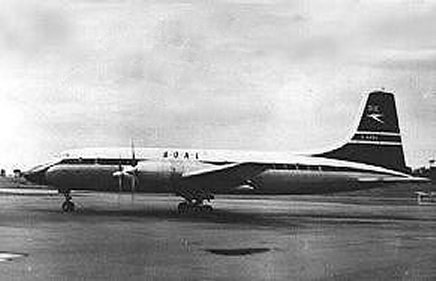 |
||||
| BOAC introduced the Britannia through Entebbe in late 1958, and in 1959 operated the Series 312 on Flight BA161 from London to Nairobi via Rome, Khartoum and Entebbe. The Britannia was notoriously unreliable on BOAC's East African services. By 1960 the Series 312 had been replaced by the smaller shorter ranged Series 102. The Post Card (left) was available in Uganda and shows a Series 312 in front of the new Tower and passenger terminal. Series 102 G-ANBD taxies to the ramp, (right) having landed on Runway 12. PHOTOs Malcolm McCrow | |||||
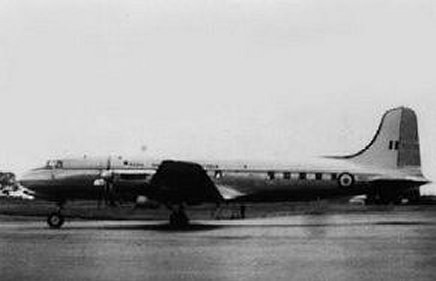 |
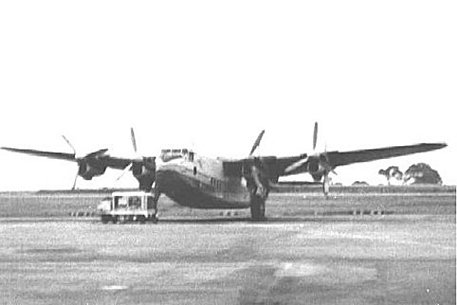 |
||||
| A Royal Rhodesian Air Force Argonaut (left) visiting Entebbe in 1960. An Avro York (right) frequently arrived with Proteus engines for stranded Britannias. PHOTOs Malcolm McCrow | |||||
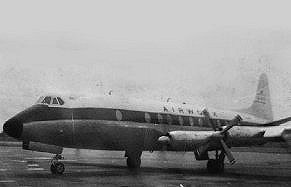 |
|
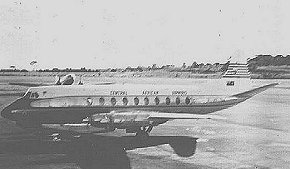 |
|||
| An Airwork Viscount 800 starts up and taxies for Runway 12 (left and centre). Central African Airways Visount 700 arrives early evening on a flight from London to Salisbury. PHOTOs Malcolm McCrow | |||||
|
|
|||||
|
A Hunting Clan Viscount 800 transits Entebbe for either Nairobi or Salisbury during the construction of the new tower and terminal in 1958. PHOTO John James |
|||||
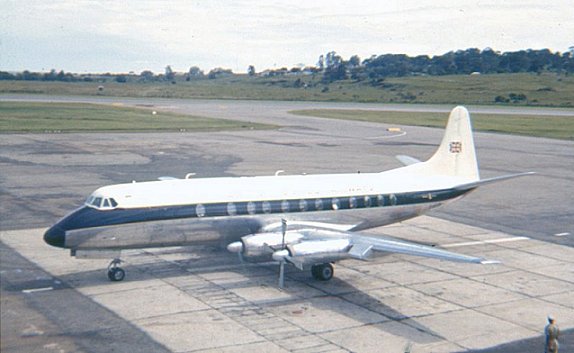 |
|||||
| Hunting Clan was to merge with Airwork in 1959 and became British United Airways. The reflection has obliterated the airline name on this photographs of a BUA Viscount 800 departing one afternoon for Nairobi. Note the long range tanks on the wings. PHOTO Malcolm McCrow | |||||
|
|
|||||
| By the early 60s BUA had replaced the Viscounts with Series 313 Britannias PHOTO Malcolm McCrow | |||||
|
|
|||||
| A Britannia 313 starts up for its overnight flight to London. PHOTO Malcolm McCrow | |||||
|
|
|||||
| BUA Britannia taxiing for Runway 12. PHOTO Malcolm McCrow | |||||
|
|
|||||
| But even BUA had the occasional mishap - here six out of eight tires punctured when landing on Runway 30. PHOTO Malcolm McCrow | |||||
|
|
|||||
|
De Havilland Dragon Rapide in front of the terminal while a Trek Constellation prepares for departure. PHOTO Malcolm McCrow |
|||||
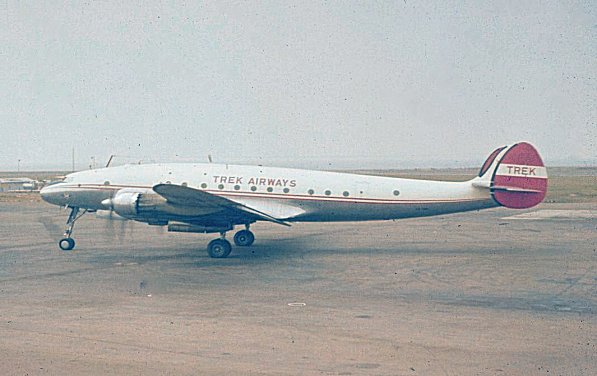 |
|||||
|
Lockheed Constellation taxies across the apron for Runway 30. PHOTO Malcolm McCrow |
|||||
|
|
|||||
|
Former SABENA DC6B in new Air Congo livery arrives Entebbe (left). It is often forgotten that SABENA, although a Belgian based airline actually had most of its fleet and routes in the Congo before that country became independent in 1960. PHOTO Malcolm McCrow |
|||||
|
|
|||||
|
C54 Skymasters on charter to the United nations during the disturbances in Congo immediately after that country's independence in 1960. PHOTO Malcolm McCrow |
|||||
|
|
|||||
| Dag Hammarskjold's SAS Convair CV-440 during a visit to Entebbe in 1960. It was rare to see SAS aircraft at Entebbe, although they frequently operated DC7Cs through Nairobi. Dag Hammarskjold was at the time Secretary General of the United Nations. He was killed shortly afterwards in the then Northern Rhodesia - now Zambia - in an accident involving a DC-6B from the Swedish Charter Company TRANSAIR. It was in this, by then abandoned, building that the hostages from the Air France Airbus were held prior to the raid on Entebbe by the Israeli Air Force to rescue them on 3/4 July 1976. PHOTO Malcolm McCrow | |||||
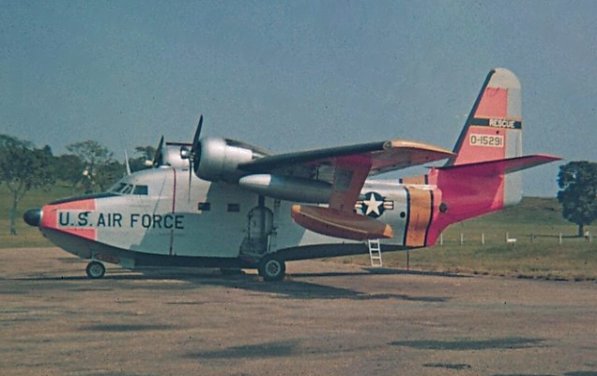 |
|||||
| Grumman HU16B Albatross arrived for the duration of the Independence Celebrations - presumably to cover the possibility of a VIP aircraft ditching in Lake Victoria. Normal cover was provided by motor launches stationed at the end of Runway 30. PHOTO Malcolm McCrow | |||||
|
|
|||||
| USAF C54 Skymasters lined up on the short runway prior to Independence on 9 October 1962. PHOTO Malcolm McCrow | |||||
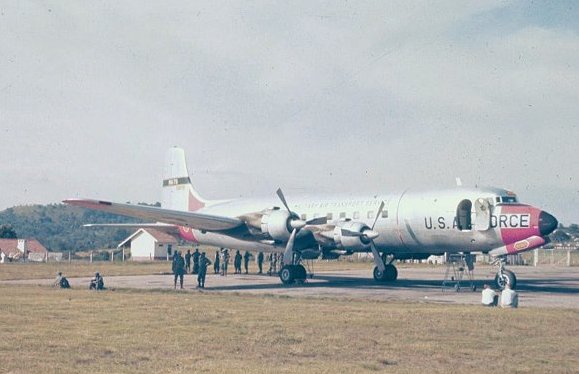 |
|||||
| USAF C118 at the end of the short runway on the Sunday before Independence. PHOTO Malcolm McCrow | |||||
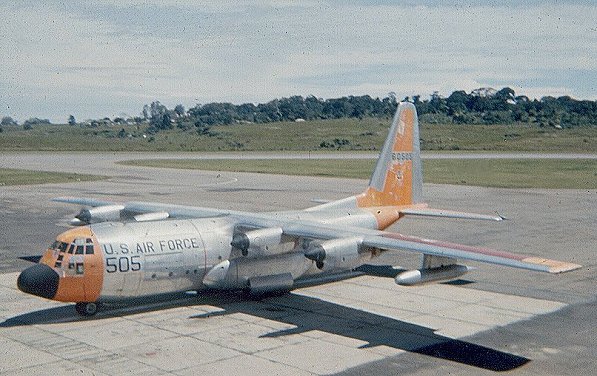 |
|||||
| USAF C130 Hercules reverses of the ramp in 1961. PHOTO Malcolm McCrow | |||||
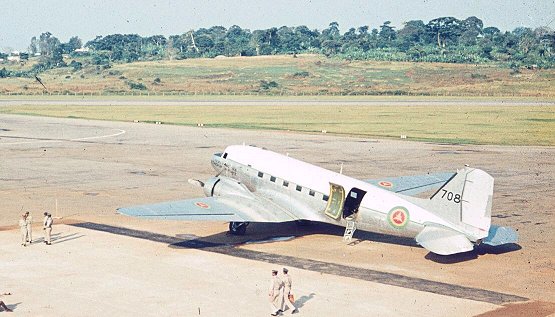 |
|||||
| Ethiopian Air Force C47B visiting Entebbe. PHOTO Malcolm McCrow | |||||
|
|
|||||
|
Vickers Valiants at Entebbe during the Independence Celebrations in 1962. PHOTO Malcolm McCrow |
|||||
|
|
|||||
| Vickers Valiant at Entebbe. A few years later they were all suddenly withdrawn from service when metal fatigue was discovered in the main spar. PHOTO Malcolm McCrow | |||||
|
|
|||||
|
Avro Vulcan at Entebbe. The RAF had contingency plans to operate V-bombers out of both Entebbe and Nairobi in the event of war. The term V-bomber referred to there being three different types of strategic bomber beginning with the letter V - the Vulcan, the Valliant and the Victor. PHOTO Hugh Burt |
|||||
|
|
|||||
|
Blackburn Beverley XH123 of the UK Air Force turned up one afternoon in 1961. PHOTO Malcolm McCrow |
|||||
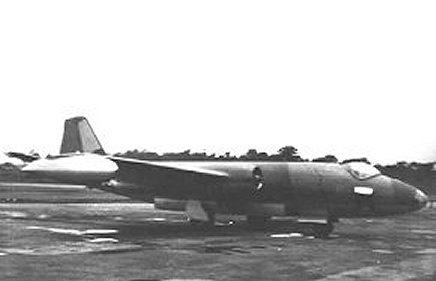 |
|
||||
|
|
A UK Air Force Canberra (above) makes a surprise visit on a rainy Saturday afternoon in 1959. This was considered to be quite a scoop and the rest of the film was used up on it. PHOTOs (above) Malcolm McCrow Consternation came some thirty minutes later. I was in the tower when a DC-2 from the Congo called for joining instructions - even the Controller was surprised and replied "Say again Aircraft type". This photo (left) taken by Brian Robbins at a South African field serves to show what I missed!
|
||||
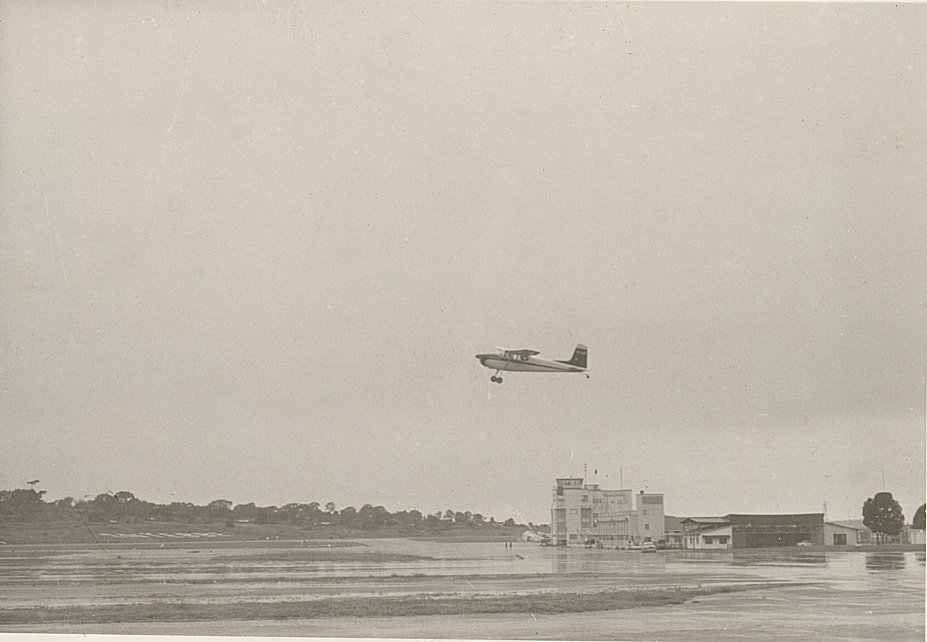 |
|||||
| A very wet Entebbe one Saturday afternoon in 1959. I used up my film on this shot and the Canberra featured above. And then the DC2 arrived! The practice, when entering the Airport on foot by the maintenance hangar was to wait by the short runway until a green light was flashed from the tower. It was then permitted to walk over to the terminal. PHOTO Malcolm McCrow | |||||
|
|
|||||
|
Photographed from under an Airwork Viscount, Entebbe Tower in 1959. PHOTO Malcolm McCrow |
|||||
|
|
|||||
| Not to be out-done, Entebbe had its own sign post modelled on east African Airways' original at Nairobi Eastleigh. PHOTO Malcolm McCrow | |||||
|
|
|||||
| Entebbe viewing platform with the restaurant next to it on the right seen from a DC3 about to depart for Nairobi. PHOTO Malcolm McCrow | |||||
|
|
|||||
|
Overnight East African Airways flight from London arriving at Entebbe having landed on Runway 12. PHOTO Malcolm McCrow |
|||||
|
|
|||||
|
Runway 30 seen from an East African Airways DC3 on Finals in the late 60s. Left centre of the picture is the Entebbe Swimming Club on its promontory. The road which runs round the airport past the hangars and the end of the runway is clearly visible. The old terminal buildings and tower were still functioning when this photograph was taken, but excavation work is well under way in preparation for the new runway and terminal which will be built to the west of the main runway. The hillside on which the famous [original] white letters spelling out ENTEBBE have already gone. PHOTO - Bret Langevad |
|||||
|
|
|||||
|
Long finals for Entebbe's Runway 17 - the old Runway 12 (still used) is clearly visible running to the left of the photograph by Brian McMorrow |
|||||
|
|
|||||
|
Short Finals for 17 as an Airbus approaches from the north at dusk on 1 July 2003. The current terminal is, as was the original, to the east of the main runway. PHOTO - Bart Noëth |
|||||
|
|
|||||
| This view of the new terminal buildings shows the "new" Runway 17/35 with the Kanyamusanga Swamp to the west and the old Runway 12/30 with the Namiro Swamp to the east. PHOTO - Brian McMorrow | |||||
|
|
|||||
|
This view looking west shows the
original apron and terminal at bottom left. The disused short Runway
18/36 runs along the bottom of the picture. The Buku road departs from the
old Airport Road and, skirting the Namiro Swamp runs the length of Runway
12/30. The road led (leads) to the rescue launch jetty in Lake
Victoria. Originally ENTEBBE was spelt out in large white letters on
the hillside to the west of the old main runway, but these letters have now
been removed to a different location. PHOTO - Brian McMorrow
Brian has an excellent photo gallery which includes other photographs of Entebbe Airport and other aerial views in East Africa. He also has an extensive collection of aerial photographs and aircraft at Brian McMorrow's Photo Galleries at pbase.com |
|||||
|
|
|
||||
|
Looking north in 2003 (left). Note the numerous Cessna Caravans, Let-410, and the Ethiopian 737 next to the Air France 747. The Africa One fleet can just be seen at extreme left - two DC9s and a DC10. Looking south in 2003 (right). An un-liveried Regional Air 737 is on the left, next to it an MD DC8 and a DC10. The most interesting part of this picture is the close up of the hill with the letters on it. The "newly" positioned ENTEBBE letters now look quite worn. PHOTOs Daniel Amtmann |
|||||
|
|
|
||||
|
Disembarkation of a British Airways Boeing 747 still showing its "ethnic cultures" tail design, no being replaced by the BA logo as shown on the BA-owned Regional Air 737 below. The "new" terminal - the old terminal is still in existence, but derelict. PHOTOs Daniel Amtmann |
|||||
|
|
|||||
|
Entebbe Airport on 1 July 2003. But not quite what it seems. Kenya Registered Boeing 737-217/Adv (5Y BPV) of Regional Airways - a British Airways subsiduary. An Air France 747 is conspicuous in the background. PHOTO Daniel Amtmann |
|||||
